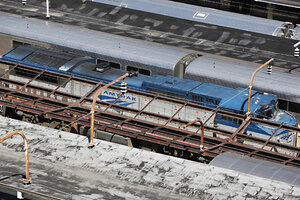Why America needs high-speed rails
As the US population grows, more transportation options will become vital in densely packed sections of the country. High speed rail (HSR) may be the best answer.

An Amtrak engine sits on the tracks at Union Station in Washington, July 25, 2012. Amtrak has plans to convert the station into a High Speed Rail hub, and Holland argues tha HSR could be the key to solving transportation issues in the most crowded regions in the US.
Jonathan Ernst/Reuters
As the population of the U.S. grows from a country of 300 million to 400 million over the next 30-40 years, we’re going to have some decisions to make about how we keep the country moving. In our biggest cities — also the source of the greatest portion of our wealth creation — the highways and transportation systems are becoming more jammed by the day. It should be obvious that more transportation infrastructure options are needed in America’s densely packed regions.
The Interstate Highway System has been successful in linking the country together, but I’m afraid that it promotes sprawling, auto dependent development — which essentially outsources a major cost (fuel) to consumers. More highways, even if they could be built to meet capacity, are not the answer for dense regions because they have proved to only encourage more oil-dependent sprawl.
I believe that High Speed Rail (HSR) is the way to build dense, interlinked cities and regions. This past week saw two major developments about the future of HSR, as the California Senate approved $4.6 billion in funding for the construction of the first section of the state’s HSR and Amtrak announced a plan for significant upgrades to the lines along the Northeast Corridor.
Political Hot Potato
High-speed rail has had a rough few years. Initially, there was some enthusiasm generated by the $8 billion investment in the 2009 stimulus legislation. However, the stimulus bill very quickly became a political football; the high-speed rail money was identified as a particular priority of President Obama’s, so it became a popular target. Republican governors in Wisconsin, Ohio, and Florida rejected the high-speed rail funding, even though the funding came with very few strings attached (compared to most other federal funding).
Ultimately, I think it was a good thing that these states rejected the funding. High-speed rail actually doesn’t make sense in most of the country — only when it can connect high density regions and cities. That means, as a 2009 report “Where HSR Works Best” (PDF) by America 2050 showed, that funding for HSR should be focused on the Northeast corridor, California, and parts of the Midwest. Of the top 20 city pairs, as ranked by their criteria, 7 were in the Boston-Washington route (including the top 4), 4 were in California, and 4 were in spokes extending from Chicago. The only route of the top 20 that didn’t include at least one city in one of those three main areas was the Dallas-Houston route in Texas.
Although the best business and efficiency case can be made for investment in those areas, the nature of political funding is to spread the funding around to many interest groups. I’m convinced that’s why we ended up with large amounts of funding initially being sent to states like Florida, Wisconsin, and Ohio. What these states have in common is not a strong potential for HSR, but that they are electoral swing-states.
As someone usually skeptical of government, the way we’re doing it — with government funding to government-sponsored companies (Amtrak or the California High Speed Rail Authority) — may not be the most efficient or effective method, but it’s the only one on the table right now. A credible conservative response would be to give tax credits or preferred financing to private companies to build and operate the lines, but the Republican party right now is more interested in shutting down rail altogether rather than building a real transportation system.
Fortunately, when their Republican governors decided to turn down the funding, that freed it up to be concentrated on where it could be most useful: the Northeast corridor and California.

